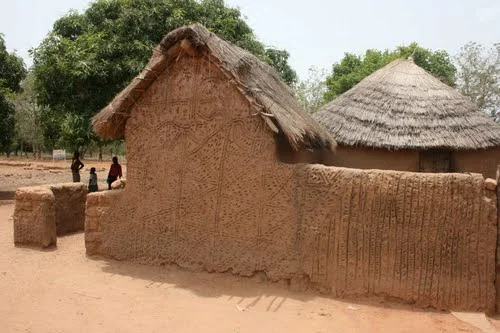By Emmanuel K. Ofori-Sarpong
A Mognori Homestead. Photo by Luis O. Boettner
Mognori has a population of roughly 400 people, majority of whom are Muslim. Their building practices are very similar to those found in other parts of the northern sector of Ghana. This paper describes the process of building construction in Mognori. The methods used include focus group discussions, interviews and direct observation.
Mognori building forms are mainly rectangular, which strengthens Prusin’s (1969) assertion that the rectangular building form entered the Northern Ghanaian vernacular architecture vocabulary due to encounters with Muslim traders. In addition, revelations from a focus group discussion with Mognori builders buttresses this as they revealed knowledge of a history of the community building round huts in the past, though they were unable to tell why that tradition was stopped. In their current framing, they indicated that the few visible round huts mean that part of the household belongs to a woman. They further indicated a dislike for round huts due to a number of reasons - for example in orientation - the round hut makes it difficult for them to determine where to think of as the ‘front’ of the house. Additionally, not having a flat wall to place the bed against during furnishing was cited as a problem.
All Mognori buildings are built in earth obtained by digging close to the specific building site. After construction, the pit is used to hold refuse. The dug mud is used in two main ways. (1) It is rolled into roughly spherical balls and used while damp or (2) moulded into bricks and sun dried. These represent the more traditional and the modern approaches respectively.
In instances where roughly spherical balls are used, the entire building takes about two weeks to complete. It is built in six to seven layers, building each new layer, only when the previous layer has dried. Whilst building, they sit on the previously built and now dried layer, whilst adding subsequent layers. When using sun-dried bricks the entire building can take two days to complete without a roof. Three main types of roofs are used, - conical roofs woven out of grasses, gable roofs with layered grasses, or flat roofs constructed in mud. Local lore says that the flat mud roofs served as spying posts against enemy raids in the past. In the present, they are used for drying crops and are slept on during hot nights. In general, Mognori builders prefer thatch roofs because they keep rooms cooler.
The final stage of the building process is the plastering and pattern making, an activity carried out entirely by women and young girls. Madam Mamuna, the most skilled pattern designer in the villager was interviewed for this paper. Most of the girls learn the art from their mothers, and pass it on to their daughters. As far as the making of patterns on the walls are concerned, the outermost walls of the house are emphasised because apart from their aesthetic appeal, the patterns increase a walls resilience to weathering through rain. Historically, the patterns were codified. They were records of birthdates, marriage dates and for keeping track of time in general. Hence they performed a dual role of granting longevity to the wall in question and of keeping information. In recent times however, the quest for modernity as well as a decreasing sense of community has put the practice of pattern-making under threat of extinction. Plain walls comparable to those found elsewhere are preferred, since they are considered a mark of the modern. The situation is further aggravated by the fact that the younger women are not interested in learning the practice, since they consider it colloquial. Finally the gradual introduction of cement as a wall finish makes it no longer necessary to create protective patterns as it were.
Vernacular building practices in Mognori are changing, as is wont to happen in vernacular architecture - adapting to socio-cultural shifts. Even though knowledge of building still remains communal, at the moment there is now a heavier reliance on specific skilled individuals, who are considered traditional masons. Where the construction is minor, involving an extension or a renovation, individuals build their own houses with the help of a friend or two. Despite this, the plastering, which is done by the women and young girls, remains a group activity.
Wall Decorations in Mognori. Photo by Luis O. Boettner


